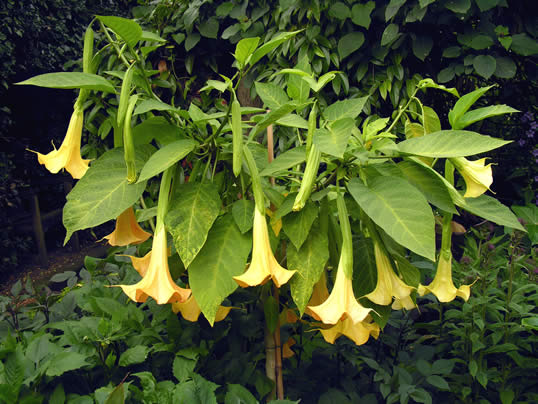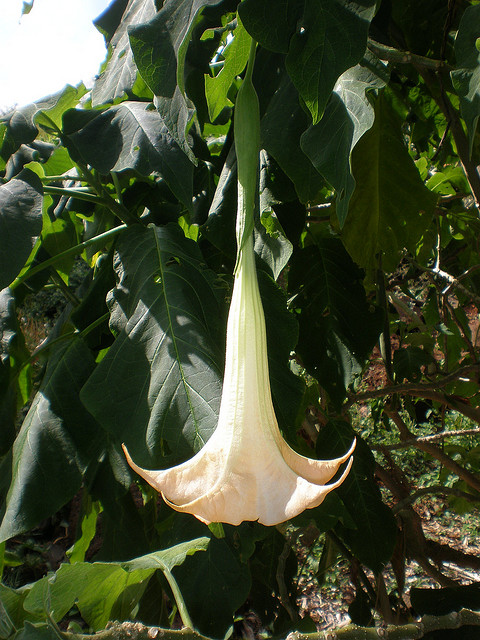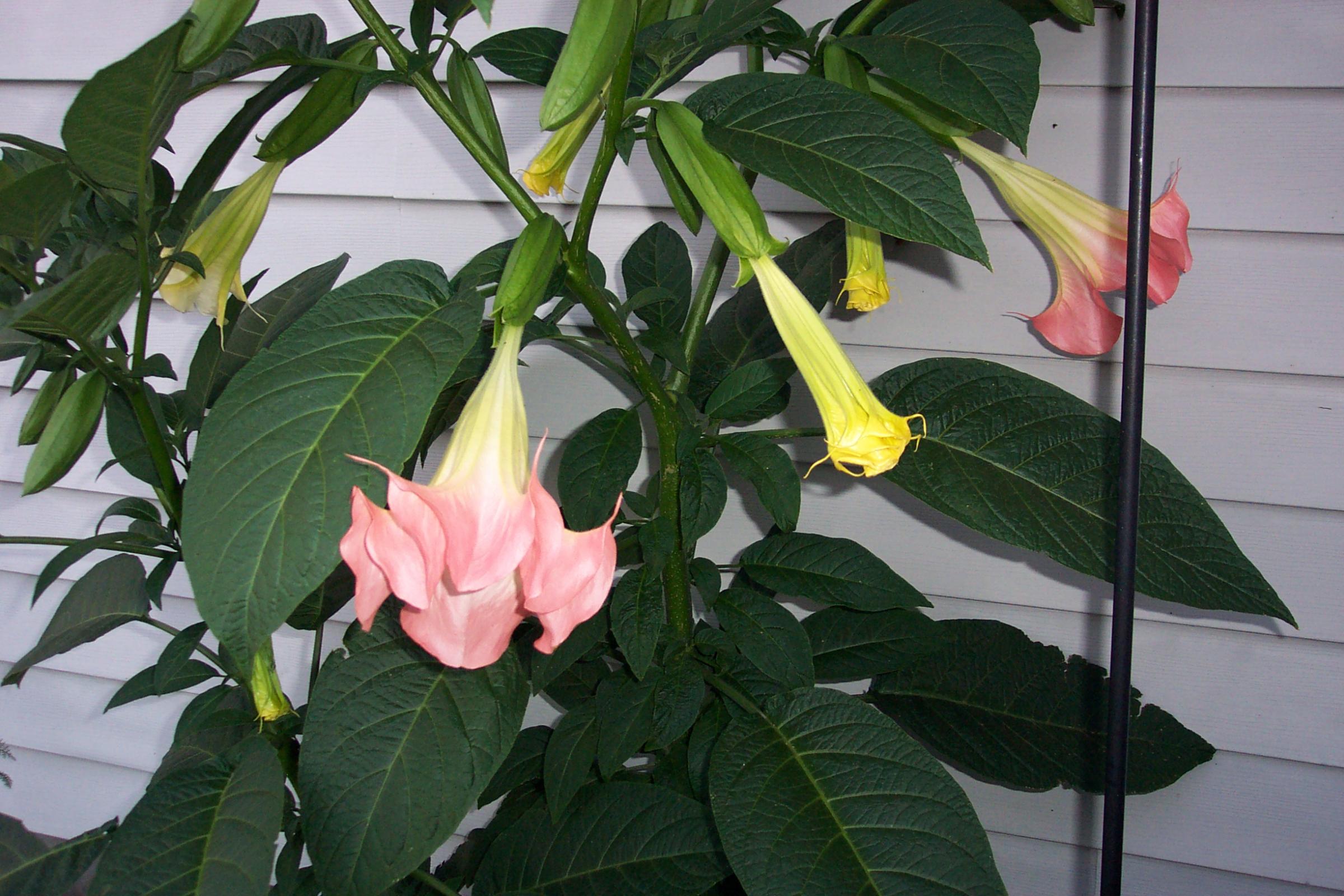
TREE DATURAS of several species are native to South America where they go by such native names as borrachero, campanilla, maicoa, floripondia, huanto, toé, and tanga. All are cultivated plants, unknown in the truly wild state and associated with man since earliest times.
Datura suaveolens is indigenous to the warmer lowlands. Recognized as toxic and narcotic, it is used as an hallucinogen, alone or as an admixture. The northern Andes, from Colombia to Peru, appears to be the center of the group's origin. Species from this region are D. arborea, D. aurea, D. candida, D. dolichocarpa, D. sanguinea, and the newly discovered D. vulcanicola
Aboriginal peoples from Colombia to Chile value these trees as sources of ritualistic hallucinogens and medicines. In Chile, the Mapuche Indians use D. candida and D. sanguinea to correct unruly children. The Jivaros say that the spirits of their ancestors admonish recalcitrant children during the hallucinations. The ancient Chibchas of Bogota used D. aurea seeds to induce stupor in the wives and slaves of dead warriors and chieftains before they were buried alive to accompany husbands and masters on the last trip.
At Sogomoza, Colombia, Indians took D. sanguinea ceremonially in the Temple of the Sun. The narcotic prepared from this red-flowered species is known locally as tonga. Many Peruvian natives still believe that tonga permits them to communicate with ancestors or other departed souls. In Matucanas, Peru, Indians say it will reveal to them treasures preserved in ancient graves, or huacas, hence the local name for the plant—huacacachu ("grave plant"). The tree daturas are sometimes considered a distinct genus: Brugmansia
A tropical nightshade with large, white, scented trumpe
t blossoms and a hallucinogenic effect.
Caution: The whole plant is very
poisonous and is particularly
dangerous for children!Growing instructions
Brugmansias are be grown as pot plants in the North
. Bottom heat greatly speeds up germination.
They need a rich, well-drained soil and
much root space. In the summer they need
frequently fertilizer. During winter they
can stay in a cellar or similar place, as they
require little light while dormant

تاتوره ٔ درختی یکی از اقسام درختی تاتوره که در ایران وجود دارداین درختچه در بندرعباس کاشته می شود و جزء درختان زینتی استکه اصلش از امریکای جنوبی (پِرو، شیلی ) است ، با
نام «تاتورة مُعطّر»
به بلندی 7ـ10 پا، دارای گلهای ... سفید و معطّر
و گاهی پُر پَر، که در باغهای جنوب ایران کاشته می شود
در مناطق خاور دور از جمله درچین و مناطق همجوار آن
از نظر خواص دارویى فرقزیادى
بین تاتوره علفى و تاتوره درختى نیست
، درتاتوره درختى ماده عامل هیوسین بیشتر و
درتاتوره علفى مقدار آتروپین بیشتر است.
ماده آتروپین نیز مردمك چشم را باز مىكند و موجب كاهش
ترشح بزاق مىگردد. ضمن اینكه عضلات مثانه را سست كرده
و در نتیجه دفع ادرار را كنترل مىكند
تاكنون 15 گونه تاتوره شناخته شده است كه 10 گونه آن
درهند مىرویند. تاتوره متل درختى درختچهاى است
و داراى گلهاى بزرگ و بزرگتر از تاتوره
علفى (استرامونیوم برگها تخممرغى صاف بدون
كرك بعضى كامل و بعضى دندانههاى عمیق دارند.
گلهاى آن بوقى آویزان به رنگ ارغوانى و .....
كپسول میوه آن ناصاف و سطح آن پوشیده از خار است.
ماده عامل الكالوئید هیوسین است كه در تخم و برگ آن وجوددارد. این
الكالوئید موجب بازشدن و اتساع مردمك چشم مىشود و اگر مقدار زیادى
خورده شود موجب هذیان، اغماء و سرانجام منتهى به مرگ مىشود.
درچین گلهاى بازشده تاتوره درختى
را صبحها به محض اینكه شبنم
صبحگاهى خشك شود، جمعآورى كرده و
درآفتاب یا باحرارت كم خشك مىكنند، این دارو تند، سمى،
بىحسكننده، ضدآسم و ضد سرفه است.

1 comment:
Do you have fruits or seeds of those for sale ?
I want to order some seeds of those plant to grow in my garden.
Thanks you
Post a Comment